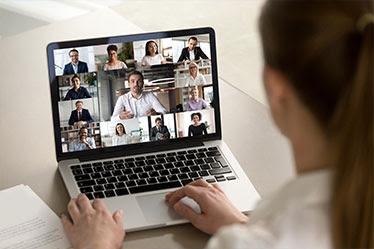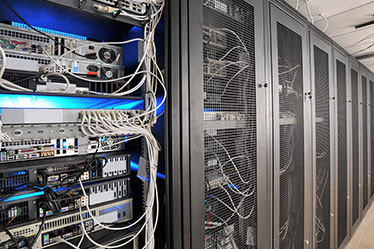
How Digital Transformation Makes You More Sustainable
Businesses must consider their impact on the environment because young consumers are more environmentally conscious than any other generation. In fact, 93% of Generation Z says that whether brands make an effort to be sustainable is an important factor when making purchase decisions.
So is your digital transformation helping make your company more or less green?
There is no doubt that technology in general and the industrialization of our world has contributed to global warming; even some of the most modern digital technologies are making it worse. At the same time, there are ways that digital can be massively helpful to your company’s “green” footprint and to the planet overall.
Let’s take a look at both sides of this equation.
8 WAYS DIGITAL IS HELPING US BECOME MORE GREEN

USING LESS
Digital is enabling us to reduce consumption in our daily lives. The media industry is a great example of drastically cutting down on consumable “stuff.” Think about all of the CDs and DVDs that are sitting in landfills.
Digital technology like streaming platforms have significantly decreased the need for hard copies of music, movies, and television series.
Additionally, when there are less consumables being manufactured and purchased, there are fewer trucks needed for shipping those products to retail stores, which cuts down on carbon emissions.
Offices and workplaces becoming paperless is another example of how digital is allowing us to use less daily. Less paper use translates to fewer trees being cut down to manufacture paper products.
SHARING MORE
More and more people are opting to share or rent their possessions and properties using digital platforms.
Airbnb allows homeowners to list their properties for rent when they aren’t being used so they don’t go to waste when the owner isn't using them.
This has become particularly popular with vacation homes; sharing these properties cuts down on the number of new vacation homes that need to be built.
Workplaces are sharing office space, as well. Many companies now use digital “hoteling” tools that allow employees to reserve an office when they need one, letting the company lease fewer floors, which allows the same building footprint to serve more tenants. This also saves on power because one less floor needs to be heated, cooled, and cleaned. Furthermore, many companies are using digital meeting tools like Zoom and collaboration tools like Slack which enable employees to work from home, further reducing the need for office space.
Ride sharing apps like Uber and Lyft allow people to request a ride from their mobile device and get where they need to go without owning a vehicle. Fewer cars on the road equals less harmful pollution, and more sharing means we may be able to manufacture less cars, saving energy and materials.
In fact, there are sharing platforms today for just about everything, from swimming pools to tools and home cooked meals.
WASTING LESS
Electricity can be conserved through digital technology. Smart homes and office buildings now have the ability to sense when a room is empty and can adjust lighting and temperature accordingly to avoid wasting power.
Aside from electricity, think about all the digital tools we have that help cut down on waste in general. For example, cars now have sensors that help prevent accidents, which, in addition to saving lives, reduces waste from totaled vehicles that would otherwise need to be replaced.
Some factories now utilize IoT (“Internet of Things”) smart sensors that send notifications when it’s time for equipment to be serviced. This helps keep expensive equipment and machinery well maintained and extends their working lives, which results in fewer replacements.

DRIVING LESS
Most car engines today create emissions and pollutants that are harmful to the environment.
Digital has enabled us to drive less. For example, when the COVID-19 pandemic started, many people began to work remotely and were no longer commuting to the office.
Tools like Zoom make this possible. Fewer people driving to work translates to less emissions that can harm the environment.
Another example is the increased availability of home delivery options like Amazon and Instacart. Those digital platforms allow you to order everything from household cleaning supplies to groceries and have them delivered right to your door. This decreases the need for consumers to make several trips to the store to do their shopping. While fuel is still burned to deliver goods, one truck uses far less fuel than dozens of households going to the store.
GREENER TRANSPORT
It’s one thing to drive less, but it’s another to use a more environmentally friendly mode of transportation. The first example that comes to mind for most people is electric vehicles. Without digital, we likely wouldn’t have the technology to create and use cars that don’t produce emissions.
Another example is route planning technology. With GPS driven tools, delivery drivers are able to optimize the most efficient routes to minimize the number of trucks they use, as well as the amount of fuel burned.
UNDERSTANDING THE PLANET
The more we understand how our ecosystems work, the better we can care for them. There are a number of digital technologies that help us do this. One example is satellite imaging. Not only can satellites take photos to help us understand sea levels and deforestation, but they can use ultraviolet and infrared light to determine things like nitrogen levels in the soil.
This information helps scientists figure out how to better conserve our natural resources.
Drones are another technology that allows us to get a different view of Earth. These devices can be used to reach remote areas that maybe scientists can’t get to themselves.
Smart tags are now used in the wild to track animals, as well. These tags bring back valuable data and provide insight on the species and their migration patterns.
EDUCATING PEOPLE
Digital tools have the potential to educate a large number of people on what’s going on in our environment. When scientists collect data from drones, satellites, etc., educational content can then be created and shared to educate others.
Media platforms like YouTube are a great source of information for people all around the world to learn about sustainability and how they can do their part to protect the environment.
MOBILIZING PEOPLE
Digital has the power to mobilize people. One of the most important factors that leads to policy change is driving human behavior.
For example, social media platforms are now being used to organize gatherings to raise awareness for climate change and pollution.
Photos of these events and peaceful protests are then posted and shared, which increases awareness and mobilizes people. Many powerful movements have been started as a result of these digital platforms.
WHAT ABOUT THE DOWNSIDES?
While digital is generally a force for good related to the environment, there are a few downsides.

POWER
Digital consumes a lot of power. Just the mining of digital currency alone is consuming 0.3% of all power consumed on Earth. That may sound like a very small portion, but when you think about all of the power that is used on a daily basis, that’s a significant percentage.
Data centers are another example. By one estimate, these centers are using approximately 500 terawatts of power each year. In order to generate that amount of power, you would need 200 giant coal fired plants. And while there are other ways of generating electricity today, most of our electricity is still generated by coal fired plants, which are harmful for the environment.
POISON
Harmful chemicals are used during the manufacturing process of digital devices like PC computers and iPhones.
Electronics manufacturing uses a lot of resources in general.
For example, making just one laptop computer takes 1.5 tons of water and 22 kilograms of harmful chemicals that are either placed in the device itself or used in the creation of the device and later become waste.
With the demand for digital devices increasing all over the world, this is an area where we have room for improvement to help protect the environment from pollution.
Clearly, digital is both a force for good and bad from a sustainability perspective. I encourage you to consider how to help your organization focus on expanding the opportunities to use digital to help make our planet (and your brand) more green while minimizing your negative environmental footprint.